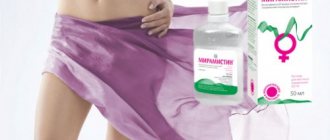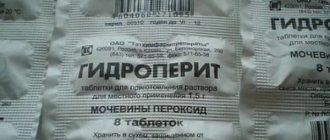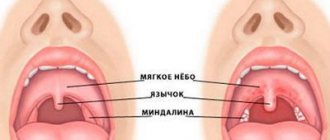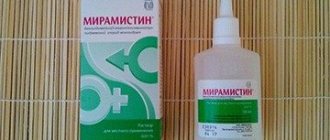Release form
The medicine is available in the form of a solution that is applied topically. It is a clear, colorless liquid that foams when shaken.
Miramistin solution is contained in polyethylene bottles of 50 ml, 100 ml, 150 ml or 200 ml, which are placed in cardboard boxes. The kit also includes a spray nozzle or spray pump.
The release form for use in a hospital setting is 500 ml bottles.
Miramistin suppositories and tablets are not available.
pharmachologic effect
The abstract indicates that Miramistin has an antimicrobial effect, including on hospital strains that are resistant to antibiotics .
The product provides a bactericidal effect against some gram-positive and gram-negative bacteria, both aerobic and anaerobic. It also acts on hospital strains that are multiresistant to antibiotics.
The antiseptic also provides an antifungal effect, influencing ascomycetes, which belong to the genus Aspergillus and Penicillium , it also affects yeast and yeast-like fungi, dermatophytes, and a number of other pathogenic fungi, including fungal microflora, which is resistant to chemotherapy means.
Wikipedia testifies that Miramistin has an antiviral effect, showing activity against complex viruses, namely the human immunodeficiency virus, herpes , etc.
The product is also active against pathogens that are sexually transmitted to humans.
The use of Miramistin helps prevent the process of infection of burns and wounds, accelerates the process of tissue restoration, stimulates the manifestation of protective reactions when applied topically, activating the absorption and digestive function of phagocytes. The drug increases the activity of the monocyte-macrophage system. There is also pronounced hyperosmolar activity, due to which wound and perifocal inflammatory processes are effectively stopped. When treated with Miramistin, rapid adsorption of purulent exudate occurs, which contributes to the active formation of a dry scab. In this case, granulation and viable cells of the skin are not damaged, and marginal epithelialization is not inhibited.
Does not have any allergenic or local irritant effect.
Indications for use
The following indications for the use of Miramistin are determined:
- In traumatology and surgery it is used to prevent suppuration and to treat purulent wounds. Used in the treatment of purulent-inflammatory diseases of the musculoskeletal system.
- In obstetrics and gynecology, the indications for use are as follows: treatment and prevention of suppuration of wounds and injuries received during childbirth, treatment of inflammatory and infectious processes of the genital organs. The doctor explains in detail how to use Miramistin in gynecology when prescribing.
- In venereology and dermatology, it is prescribed for the treatment and prevention of dermatomycosis, pyoderma, and is also used for candidiasis of the skin and mucous membranes, in particular, for thrush.
- In urology, Miramistin is prescribed for urethritis and urethroprostatitis. Treatment with the drug is practiced for acute and chronic urethritis.
- In dentistry, it is prescribed for the purpose of preventing the treatment of infectious and inflammatory processes occurring in the oral cavity. Treatment with Miramistin is practiced for stomatitis (possible use for stomatitis in children), gingivitis , periodontitis. The product is also used to treat removable dentures.
- In otorhinolaryngology it is used for sinusitis , otitis, laryngitis , pharyngitis, chronic tonsillitis. Miramistin is prescribed for sore throat . In particular, the drug is used in complex therapy for pharyngitis, chronic tonsillitis, as well as for sore throat in children from the age of three.
- The product is also used in the treatment of deep and superficial burns, in the process of preparing wounds resulting from burns for dermatoplasty.
- The solution is used for individual prevention of the development of diseases that are sexually transmitted to humans.
Miramistin for children
Miramistin is an antiseptic with a wide range of applications. Has antiviral, antibacterial and antifungal effects. It contains the active ingredient – miramistin and purified water. No other components are included in the composition, so allergic reactions to the drug are very rare, and there are no contraindications as such.
This medicine is prescribed to children in the following cases:
- colds, flu, runny nose;
- acute pharyngitis, sore throat;
- chronic tonsillitis, laryngitis;
- herpes rashes;
- stomatitis, gum inflammation;
- thrush, urethritis and other genitourinary diseases;
- burns, cuts, wounds, skin damage of various types;
- otitis;
- chickenpox.
In addition, the drug is used as a prophylactic agent in the fight against acute respiratory viral infections and colds.
If it is necessary to replace Miramistin with another drug, you should carefully study the composition, instructions for use and the advisability of taking it, depending on the diagnosis given to the child.
You should not select similar medications on your own; the information on the Internet and instructions for use are for informational purposes only and consultation with a doctor is necessary.
Instructions for use of Miramistin (Method and dosage)
If a patient is prescribed Miramistin, the instructions for use must be carefully followed. Before using the solution contained in the package with a spray nozzle, you must remove the cap and attach the spray nozzle to the bottle. The nozzle must be activated by pressing the nebulizer again, after which the medicine can be used.
When treating wounds and burns, the solution is used to irrigate burns and wounds; the drug is also used to wet gauze swabs.
In gynecology, during the postpartum days, vaginal irrigation is practiced, which is carried out for 5-7 days. If a child is born by cesarean section , the vagina is treated with Miramistin before the operation. During the operation, the uterine cavity, as well as the incision made on it, is treated with a solution. Next, after the operation, tampons with a solution are inserted into the vagina, like suppositories, for one week. Tampons should be kept in the vagina for two hours.
If Miramistin spray is prescribed for purulent sinusitis, the instructions for use stipulate that the drug should be used to rinse the maxillary sinus during the puncture. How to rinse your nose at home should be learned from the doctor who prescribes the drug.
For tonsillitis , purulent sinusitis, pharyngitis, you should either irrigate the throat using a special nozzle, or gargle. How to gargle with Miramistin depends on the intensity of the symptoms of the disease. As a rule, 10-15 ml of product is used per rinse. The product can also be used for inhalation.
Instructions for use of Miramistin for children with tonsillitis or acute pharyngitis include irrigation. For children 3-6 years of age, irrigation is carried out with a single press; irrigation is carried out 3 or 4 times per day. Children from 7 to 14 years old are irrigated by double pressing, the frequency is 3-4 times a day. Duration of treatment is from 4 to 10 days.
Miramistin for angina is used to treat both adults and children in the form of rinses and inhalations. For sore throat in children, rinsing is done 4-5 times. Miramistin for inhalation with a nebulizer can only be used if prescribed by a specialist. The fact is that inhalation with Miramistin through a nebulizer produces a very fine spray, which can sometimes cause an allergic reaction.
Miramistin can be instilled into the nose only after a doctor’s prescription. Whether this remedy can be dripped into the nose depends on the individual characteristics of the course of the disease. When using medicine for a runny nose, it should be borne in mind that this solution can irritate the nasal mucosa. You should use the product especially carefully when you have a runny nose in children, considering what Miramistin is and what properties the solution has.
Patients with stomatitis and other dental diseases should rinse their mouth 3 to 4 times a day. How to rinse your mouth depends on the disease, but generally 10-15 ml of product is used for one rinse.
The solution is used to treat affected surfaces if it is necessary to get rid of acne.
Miramistin packaging with a urological attachment is used in urology and venereology. How to do douching, and under what conditions it is advisable to use it, should be learned from your doctor.
Miramistin spray is injected into the urethra for the treatment of urethritis and urethroprostatitis. Injection is carried out 1-2 times a day in a dose of 2-3 ml of the product for 10 days.
It should be taken into account when using Miramistin that this remedy is also used for the prevention of sexually transmitted diseases. However, it is only effective if used no later than two hours after sex. You should clearly know how to use the solution for this purpose: you need to inject the drug into the urethra for 2-3 minutes: men inject 2-3 ml of the product, women - 1-2 ml into the urethra and another 5-10 ml into the vagina. It is also necessary to treat the skin on the genitals and thighs.
Miramistin for thrush , as well as for inflammatory diseases of the female genital organs, is administered intravaginally, for which a tampon is moistened with the solution. For thrush in women, douching is also done, which should be done for seven days.
Whether Miramistin can be dripped into the ear depends on the disease and the intensity of the symptoms. If the patient is diagnosed with purulent otitis media, 2 ml of solution must be injected into the external auditory canal.
Buy Miramistin local solution. with spray 150ml in pharmacies
Instructions for use Miramistin local solution. (with spray) 150ml
Dosage forms solution 0.01%
Synonyms Okomistin Group Antiseptics International nonproprietary name Benzyldimethyl-myristoylamino-propylammonium Composition Active substance: benzyldimethyl[3-myristoylamino)propyl] ammonium chloride, monohydrate (miramistin, in terms of anhydrous substance) - 0.1 g. Manufacturers Infamed (Russia) Pharmacological action Miramistin has a pronounced bactericidal effect against gram-positive and gram-negative, aerobic and anaerobic bacteria in the form of monocultures and microbial associations, including hospital strains with multidrug resistance to antibiotics. The drug is more effective against gram-positive bacteria (Staphylococcus spp., Streptococcus spp., Streptococcus pneumoniae, etc.), acts on pathogens of sexually transmitted diseases (Chlamydia spp., Treponema spp., Trichomonas vaginalis, Neisseria gonorrhoeae), as well as herpes viruses, human immunodeficiency, etc. Has an antifungal effect on ascomycetes of the genus Aspergillus and the genus Penicillium, yeast fungi (Rhodotorula rubra, Torulopsis gabrata, etc.) and yeast-like fungi (Candida albicans, Candida tropicalis, Candida krusei, etc.) , dermatophytes (Trichophyton rubrum, Trichophyton mentagrophytes, Trichophyton verrucosum, Trichophyton schoenleini, Trichophyton violacent, Epidermophyton Kaufman-Wolf, Epidermophyton floccosum, Microsporum gypseum, Microsporum canis, etc.), as well as other pathogenic fungi, for example, Pityrosporum orbiculare ( Malassezia furfur), in the form of monocultures and microbial associations, including fungal microflora with resistance to chemotherapeutic drugs. Effectively prevents infection of wounds and burns, activates regeneration processes. It has pronounced hyperosmolar activity, as a result of which it stops wound and perifocal inflammation, absorbs purulent exudate, promoting the formation of a dry scab. Does not damage granulations and viable skin cells, does not inhibit marginal epithelialization. Does not have a local irritant effect or allergenic properties. Pharmacokinetics. When applied topically, Miramistin does not have the ability to be absorbed through the skin and mucous membranes. Side effects In some cases, a slight burning sensation may occur at the site of application, which goes away on its own after 15 - 20 seconds and does not require discontinuation of the drug. Allergic reactions. Indications for use Surgery, traumatology: prevention of suppuration and treatment of purulent wounds; treatment of purulent-inflammatory processes of the musculoskeletal system. Obstetrics, gynecology: prevention and treatment of suppuration of postpartum injuries, wounds of the perineum and vagina, postpartum infections; inflammatory diseases (vulvovaginitis, endometritis). Combustiology: treatment of superficial and deep burns of II and IIIA degrees; preparation of burn wounds for dermatoplasty. Dermatology, venereology: treatment and prevention of pyoderma and dermatomycosis, candidiasis of the skin and mucous membranes, mycoses of the feet. Individual prevention of sexually transmitted diseases (syphilis, gonorrhea, chlamydia, trichomoniasis, genital herpes, genital candidiasis, etc.). Urology: complex treatment of acute and chronic urethritis and urethroprostatitis of specific (chlamydia, trichomoniasis, gonorrhea) and nonspecific nature. Dentistry: treatment and prevention of infectious and inflammatory diseases of the oral cavity: stomatitis, gingivitis, periodontitis, periodontitis. Hygienic treatment of removable dentures. Otorhinolaryngology: complex treatment of acute and chronic otitis, sinusitis, tonsillitis, laryngitis. Contraindications Individual intolerance to the drug. Method of administration and dosage The drug is ready for use. Directions for using the spray bottle: Remove the cap from the bottle. Remove the supplied spray nozzle from its protective packaging. Attach the spray nozzle to the bottle. Activate the spray nozzle by pressing again. Surgery, traumatology, combustiology. For preventive and therapeutic purposes, the surface of wounds and burns is irrigated, wounds and fistula tracts are loosely tamponed, gauze swabs soaked in the drug are fixed. The treatment procedure is repeated 2-3 times a day for 3-5 days. A highly effective method of active drainage of wounds and cavities with a daily consumption of up to 1 liter of the drug. Obstetrics, gynecology. In order to prevent postpartum infection, it is used in the form of vaginal irrigation before childbirth (5-7 days), during childbirth after each vaginal examination and in the postpartum period, 50 ml of the drug in the form of a tampon with an exposure of 2 hours, for 5 days. When women give birth by cesarean section, the vagina is treated immediately before the operation, the uterine cavity and the incision on it are treated during the operation, and in the postoperative period tampons soaked in the drug are inserted into the vagina with an exposure of 2 hours for 7 days. Treatment of inflammatory diseases is carried out over a course of 2 weeks by intravaginal administration of tampons with the drug, as well as by the method of medicinal electrophoresis. Venereology. For the prevention of sexually transmitted diseases, the drug is effective if it is used no later than 2 hours after sexual intercourse. Using a urological applicator, insert the contents of the bottle into the urethra for 2-3 minutes: for men (2-3 ml), for women (1-2 ml) and into the vagina (5-10 ml). Treat the skin of the inner thighs, pubis, and genitals. After the procedure, it is recommended not to urinate for 2 hours. Urology. In the complex treatment of urethritis and urethroprostatitis, 2-3 ml of the drug is injected into the urethra 1-2 times a day, the course is 10 days. Otorhinolaryngology. For purulent sinusitis, during puncture the maxillary sinus is washed with a sufficient amount of the drug. Tonsillitis, pharyngitis and laryngitis are treated by gargling and/or irrigation using a spray nozzle, pressing 3-4 times, 3-4 times a day. The amount of drug per rinse is 10-15 ml. Dentistry. For stomatitis, gingivitis, periodontitis, it is recommended to rinse the mouth with 10-15 ml of the drug, 3-4 times a day. Overdose No data available. Interaction When used simultaneously with antibiotics, an increase in their antibacterial and antifungal properties was noted. Special instructions No data available. Storage conditions Store out of the reach of children at a temperature not exceeding 25 C.
special instructions
No mutagenic effects of the drugs were detected during the study.
Do not allow the product to come into contact with the eyes. Miramistin for eyes is used only after prescription by a specialist. At the same time, you should definitely ask your doctor about whether it is possible to wash your eyes with this solution and how to do it correctly. For the treatment of eye diseases, the drug Okomistin based on miramistin .
Since this remedy has a wide range of effects, it is prescribed for mixed fungal and bacterial infections. As a rule, this occurs at the first stage of therapy, before a diagnosis is made.
Analogues of Miramistin
Level 4 ATC code matches:
Drapolene
Miramistin Darnitsa
Dekasan
Analogues of Miramistin in Russia are the drugs Chlorhexidine , Decasan , Octenisept , etc. The price of analogues can be higher or lower. However, only a specialist can finally determine what can replace Miramistin in each specific case.
Which is better: Miramistin or Chlorhexidine?
Often, when looking for a drug that can replace Miramistin, this drug is compared with the drug Chlorhexidine. Answering the question of what is the difference between Chlorhexidine and Miramistin, experts note that Chlorhexidine is more toxic and also provokes the development of more pronounced side effects. These drugs have different compositions, although the indications for use are almost the same. But doctors consider Miramistin a safer and gentler remedy, which is why it can be prescribed for the treatment of children. At the same time, Chlorhexidine has more pronounced antimicrobial activity.
How to replace Miramistin for a child
For ENT diseases, the drug will be replaced by various local agents in the form of aerosols:
- Kameton;
- Hexaspray;
- Tantum Verde;
- Oralcept;
- Maxicold Lore;
- Stopangin;
- Hexoral;
- Yox;
- Lugol.
For sore throats, pharyngitis, tonsillitis, medications in the form of tablets and lozenges can also be prescribed:
- Lysobacter;
- Hexalize;
- Carmolis;
- Septolete;
- Strepsils;
- Gorpils.
It should be remembered that each of these drugs has age restrictions; you must carefully study the instructions. Minimum age for use is 3 years.
For stomatitis and similar inflammations of the oral cavity, rinses are prescribed for treatment. In this case, antiseptic solutions will become analogues for Miramistin:
- Hexoral;
- Rotokan;
- Chlorophyllipt;
- Furacilin.
The frequency of use and concentration is determined by the doctor, depending on the complexity of the disease.
Also, for lesions of the oral mucosa, tablets are used:
- Lysozyme;
- Grammidin;
- Imudon;
- Septolete;
- Faringosept.
Sometimes sprays and solutions are prescribed:
- Lugol;
- Vinilina;
- Yoxa;
- Hexoral;
- Oralcept.
In cases of skin damage or infection, antiseptics are recommended:
- Vinylin;
- Betadine;
- Iodinol;
- Furacilin;
- Octenisept.
All of these drugs can replace Miramistin during the treatment of a specific disease, but have a narrow focus of action.
If you select an analogue antiseptic drug for wide use, the most recommended are:
- Dekasan;
- Dioxidine;
- Chlorhexidine.
These products have similar effects, but differ in composition and properties.
For children
Miramistin for children is prescribed for acute pharyngitis, as well as for exacerbation of chronic tonsillitis. The instructions for Miramistin spray for children stipulate that the product is prescribed to children under 3 years of age only according to indications. Children under one year of age should be treated with the solution under the supervision of a specialist.
You should be careful when dripping Miramistin into the nose of a child with a runny nose, as irritation of the mucous membrane is possible. Inhalations using this drug are rarely prescribed to children. For chickenpox in children, the affected skin surface can be treated with a solution. For conjunctivitis in children, it is advisable to use other drugs, since Miramistin can provoke the development of allergic reactions.
Miramistin for infants is used for irrigation using a spray nozzle. For infants, the product can also be used to treat surfaces that require disinfection.
Dioxidine
The solution of this drug, in addition to water for injection, contains a single component with a rather complex name - hydroxymethylquinoxaline dioxide.
Dioxidin belongs to the group of synthetic antibacterial and bactericidal agents.
It is used mainly in the treatment of various purulent-inflammatory diseases:
- peritonitis;
- purulent meningitis;
- septic conditions;
- burn and purulent wounds;
- otitis;
- some forms of rhinitis;
- sinusitis.
This drug has a number of side effects, depending on the use. With intracavitary or intravenous administration, the following are possible: nausea, vomiting, chills, headaches, increased body temperature and various allergic reactions. Local application may be accompanied by: itching and dermatitis.
Contraindications:
- adrenal insufficiency;
- hypersensitivity to the components of the drug;
- pregnancy and lactation, children under 18 years of age.
Despite the fact that Dioxidin has an age limit, it is sometimes prescribed to children. This is done in cases where the benefits of treatment outweigh the possible harm. For example, if the use of another drug does not give the desired effect, and the patient’s condition worsens. Most often, children are treated with Dioxidin in a hospital, under strict supervision.
Chlorhexidine
It is also possible to use it for a severe runny nose, sore throat and other diseases at home, if the doctor considers it appropriate to use this medicine, strictly following the instructions. Dioxidin can be used as an analogue of Miramistin, but more often for adult patients. This drug should be given to children with great caution and only in cases of urgent need.
Dioxidin is considered quite toxic, so in no case should you treat a child with it without a doctor’s recommendation. In addition, it is necessary to strictly follow all recommendations for use: dosage, frequency of administration, course duration, etc.
Miramistin during pregnancy and lactation
Miramistin can be used during pregnancy , as well as during breastfeeding, if there are appropriate indications. If you gargle during pregnancy, or drop Miramistin into your nose during pregnancy, the likelihood of absorption of the active substance into the bloodstream is unlikely. Therefore, Miramistin can be used for the throat, as well as for disinfecting affected surfaces during pregnancy. You should ask your doctor in detail how to use the medicine. During pregnancy, during treatment with this drug, it is necessary to periodically observe a specialist.
Reviews about Miramistin
There are often positive reviews of Miramistin on the Internet. Patients note that this drug is indeed a very effective antiseptic. Women write about its use in gynecology, which made it possible to quickly cure infectious diseases of the genital organs.
Reviews of Miramistin for children indicate that the solution speeds up the healing process of wounds, it is effective for sore throat and other diseases. Reviews of the spray for children contain virtually no information about side effects. In rare cases, parents write about the manifestation of a short-term burning sensation. Many users also write that the solution helped them quickly get rid of acne and speed up the healing of burns.
Given the fact that the medicine is a universal antiseptic, Miramistin is often used for the throat. Using it to rinse with a sore throat, users note that after a few days there is a pronounced relief of the condition. A good effect also appears after spraying the solution into a child’s throat and even into an infant’s throat. Often, gargling provides some relief after the first use. Sometimes patients ask if they can swallow the solution, to which doctors warn them against such actions.
Dekasan
The main active ingredient in the drug is decamethoxin.
In addition, the composition includes sodium chloride and water for injection.
Available in the form of a clear solution.
An antiseptic drug that has the ability to fight fungi, protozoa, viruses, and also has a bactericidal effect.
The drug can be prescribed to children for the following indications:
- skin diseases of a pustular, bacterial, fungal nature;
- stomatitis, gingivitis, etc.;
- pathologies of the upper respiratory tract, respiratory system: bronchitis, laryngitis, sore throat, etc.;
- thrush and other diseases of the genitourinary system.
This medicine has no contraindications or age restrictions. Individual intolerance to the active substance or components is possible.
Side effects can manifest themselves in the form of allergic reactions on the skin - redness, hives, and sometimes a quickly passing burning sensation upon application.
Used externally, as a rinse, applied to the affected area, to rinse the nose. Decasan can also be used through a nebulizer.
You can start inhaling with this remedy when the first signs of acute respiratory infections appear. The drug moisturizes and disinfects the mucous membrane, helps to quickly get rid of the runny nose, laryngitis, and laryngotracheitis. The nebulizer is also used in the treatment of stomatitis and periodontitis.
When carrying out inhalations, you should remember that the drug cannot be used in its pure form for children under 12 years of age. It must be diluted with saline solution in a 1:1 ratio.
Miramistin price, where to buy
You can buy Miramistin (solution) at any pharmacy without a doctor's prescription. How much this product costs at the pharmacy depends on the volume of the package. The price of Miramistin in pharmacies averages 200-300 rubles per 50 ml. The price of Miramistin spray for children 150 ml is on average 370 rubles. A 500 ml bottle costs about 800-1000 rubles. How much a medicine costs in a pharmacy in Krasnoyarsk and in other cities of Russia should be found out at specific places where medicines are sold.
The price of Miramistin in Ukraine (Kharkov, Odessa, other cities) ranges from 60 to 80 UAH. per bottle 50 ml. The cost of the product in Belarus is on average 50,000 rubles. per bottle 50 ml.
- Online pharmacies in RussiaRussia
- Online pharmacies in UkraineUkraine
LuxPharma* special offer
- Miramistin ointment 5 mg/g tube 30 g
RUB 1,380 order
ZdravCity
- Miramistin solution of places. approx. 0.01% 150ml Infamed/Infamed K LLC
410 rub. order
- Miramistin solution of places. approx. 500ml Infamed/Infamed K LLC
RUB 836 order
- Miramistin solution of places. approx. 0.01% 50ml Infamed/Infamed K LLC
RUB 255 order
- Miramistin solution of places. approx. 0.01% 50ml Infamed LLC Infamed/Infamed K
RUB 218 order
- Antimicrobial sterile plaster with miramistin Dokaplast 8cm x 15cm 25 pcs. LLC New Dressing materials
RUR 434 order
Pharmacy Dialogue
- Miramistin (vial 0.01% 500ml)Infamed
RUB 895 order
- Miramistin (vial 0.01% 50ml + urological nozzle + spray) Infamed
RUB 262 order
- Miramistin bottle 0.01% 500mlInfamed
RUB 862 order
- Miramistin bottle 0.01% 150ml with spray Infamed
RUB 395 order
- Miramistin bottle 0.01% 50mlInfamed
RUB 209 order
show more
Pharmacy24
- Miramistin-Darnitsa 5 mg/g 30 g ointment PrAT" Pharmaceutical company "Darnitsa", Ukraine
65 UAH. order - Miramistin-Darnitsa 0.5% 15 g ointment PrAT" Pharmaceutical company "Darnitsa", Ukraine
32 UAH order
- Miramistin 50 ml solution PrAT" Pharmaceutical company "Darnitsa", Ukraine
80 UAH order
- Methyluracil with miramistin 30 g ointment PrAT” Pharmaceutical company “Darnitsa”, Ukraine
68 UAH order











